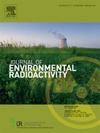空气凋落物对森林附近地区放射性元素再分布的影响
IF 2.1
3区 环境科学与生态学
Q3 ENVIRONMENTAL SCIENCES
引用次数: 0
摘要
2011年福岛第一核电站事故后,放射性铯(137Cs)沉积在整个森林地区。虽然内部循环是众所周知的,但通过凋落物的横向转移仍不清楚。本研究在阔叶林和杉木林中设置了距离林缘20 m的采集器,对137Cs的扩散进行了量化。在19个月内,测量了凋落物质量和137Cs沉积。凋落物向林缘外数米分散,特别是在强风作用下,137Cs沉降随距离呈指数递减。从2011年到2018年,估计通过凋落物累积的沉降量在杉木林0.5 m处达到初始沉降量的15.1%,在8 m处达到0.61%;在阔叶林中,这一数值分别为2.8%和0.31%。森林外的凋落物对放射性元素的再分配有重要贡献,应在长期补救规划中予以考虑。本文章由计算机程序翻译,如有差异,请以英文原文为准。

Impact of airborne litterfall on radiocesium redistribution in areas adjacent to forests
Following the 2011 Fukushima Daiichi Nuclear Power Plant accident, radiocesium (137Cs) was deposited across forested areas. While internal cycling is well known, lateral transfer via litterfall remains unclear. This study quantified 137Cs dispersal from Japanese cedar and deciduous broad-leaved forests using collectors set up to 20 m beyond the forest edge. Over 19 months, litterfall mass and 137Cs deposition were measured. Litterfall dispersed several meters beyond forest edges, especially under strong winds, and 137Cs deposition decreased exponentially with distance. From 2011 to 2018, estimated cumulative deposition via litterfall reached 15.1 % of the initial fallout at 0.5 m and 0.61 % at 8 m in the cedar forest; in the broad-leaved forest, the values were 2.8 % and 0.31 %, respectively. Litterfall outside of the forest contributes significantly to radiocesium redistribution and should be considered in long-term remediation planning.
求助全文
通过发布文献求助,成功后即可免费获取论文全文。
去求助
来源期刊

Journal of environmental radioactivity
环境科学-环境科学
CiteScore
4.70
自引率
13.00%
发文量
209
审稿时长
73 days
期刊介绍:
The Journal of Environmental Radioactivity provides a coherent international forum for publication of original research or review papers on any aspect of the occurrence of radioactivity in natural systems.
Relevant subject areas range from applications of environmental radionuclides as mechanistic or timescale tracers of natural processes to assessments of the radioecological or radiological effects of ambient radioactivity. Papers deal with naturally occurring nuclides or with those created and released by man through nuclear weapons manufacture and testing, energy production, fuel-cycle technology, etc. Reports on radioactivity in the oceans, sediments, rivers, lakes, groundwaters, soils, atmosphere and all divisions of the biosphere are welcomed, but these should not simply be of a monitoring nature unless the data are particularly innovative.
 求助内容:
求助内容: 应助结果提醒方式:
应助结果提醒方式:


